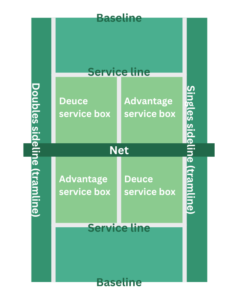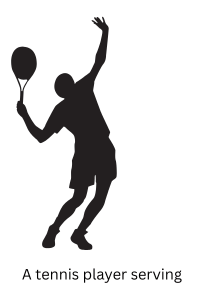Tennis Terms | List & Definitions
Tennis, like all sports, has its own unique vocabulary to describe its rules, scoring system, and shots. The game is thought to have originated in 12th-century France, which explains why some English tennis terms are particularly unusual, as they come from Old French. If you’re new to tennis, the table below contains a list of 20 essential terms to help you follow TV commentaries and join in conversations about the sport.
| Tennis term | Definition |
|---|---|
| Game | In tennis, you play points to win games; you need at least four points to win a game. |
| Set | You have to win at least six games to win a set. The first player to win an agreed number of sets is the winner of the whole match; in professional tennis, this is usually two or three sets (i.e., “best of three sets” or “best of five sets”). |
| Love, 15, 30, and 40 | You don’t count points in the usual way in tennis: Zero points is called “love,” one point is 15, two points is 30, and three points is 40. |
| All | You can say that the score in a game is equal by saying “15 all,” “30 all,” etc. |
| Deuce | When both players reach 40, the score is “deuce.” From deuce, a player must win one point to gain the “advantage” and then win the next point to take the game. |
| Advantage | At deuce, the player who wins the next point has the advantage. If they win the following point (a game point), they take the game. If they lose it, the score returns to deuce. Play continues until one player wins a game point. |
| Tiebreak | If the score in a set reaches “six all” (6-6), you play a special game called a “tiebreak” (or “tiebreaker”). The winner of the tiebreak game wins the set. The points are counted normally in a tiebreak. You win the tiebreak if you have at least seven points and two more than the other player (e.g., 7-3, 7-5, 8-6, or 13-11). In some tennis tournaments, if there is a tiebreak in the final set—which therefore decides the whole match—you have to win at least 10 points. |
| Serve (service) | The player with the “serve” (or “service”) starts all the points in a game. The serve then switches to the other player for the next game and continues to alternate like this. |
| Break serve | If you “break serve,” you win a game when the other player has the serve. |
| First serve (first service), second serve (second service) | The player with the serve has two chances to start the point by hitting it into the correct box on the other side of the net. These chances are called “first serve” (or “first service”) and “second serve” (or “second service”). If the server misses a second serve, they lose the point. |
| Double fault | It’s a “double fault” when you lose the point because you make mistakes on both your first and second serves (e.g., hit the serves “out” or into the net). |
| Ace | An “ace” is a serve that the other player is not able to hit (e.g., because the serve is very fast and difficult to reach). |
| Rally | A “rally” is a series of shots. For instance, if each player hits the ball two or three times during a point, this is considered a “short rally.” If they each hit it ten times, then it’s considered a “long rally.” |
| Forehand | A “forehand” is a shot hit with the front of the racket, where the ball is to the right of a right-handed player or to the left of a left-handed player. |
| Backhand | A “backhand” is a shot hit with the back of the racket, where the ball is to the left of a right-handed player or to the right of a left-handed player. |
| Volley | A shot where the player hits the ball before it bounces, typically played when a player is near to the net. |
| Topspin | If you hit a “topspin” shot, then the top of the ball is spinning in the same direction as the shot. Topspin lets you hit the ball hard while keeping control because the spin makes the ball dip quickly after it goes high over the net. |
| Backspin (slice) | If you hit a “backspin” (or “slice”) shot, then the ball is spinning in the opposite direction to the shot. Backspin shots are typically slow and low and don’t bounce as high as topspin shots. |
| Baseline | The “baselines” are the two lines at either end of the court. |
| Smash | A “smash” is a powerful shot where a player hits the ball when it is high in the air above their head. |
Tennis score terms
In tennis, you win points to win the game, you win games to win the set, and you win sets to win the match.
Saying the score in tennis
To win a game, you need to win points, but you don’t call the points 1, 2, 3, 4, etc.; you call them love (zero points), fifteen (1 point), thirty (2 points), and forty (3 points). If you say the word “all” after a score, it means that both players have the same points score. For example, “fifteen all” means that both players have 15.
During a game, the same player serves (starts each point) for the whole of that game. The other player is the receiver, and they serve for the whole of the next game. When you say the score while a game is in progress, you always say the server’s score first. For example, “fifteen thirty” means that the server has 15 and the receiver has 30.
Deuce
If you have a score of 40, you have game point, because you only need one more point to win the game—except if both players have 40, which is called a deuce.
The player who wins the next point after a deuce has the advantage and game point, because if you win a point when you have the advantage, you win the game.
If you lose a point when you have the advantage, the score goes back to deuce. There’s no limit to the number of deuces that can happen in a game. In 2023, a game in a match between Carlos Alcaraz and Novak Djokovic at the Wimbledon Championships in the UK had 13 deuces.
| The server … | The receiver … | How you say the score |
|---|---|---|
| … has 1 point | … has 0 points | “Fifteen love” |
| … has 0 points | … has 1 point | “Love fifteen” |
| … has 2 points | … has 0 points | “Thirty love” |
| … has 2 points | … has 2 points | “Thirty all” |
| … has 0 points | … has 3 points | “Love forty” |
| … has 3 points | … has 3 points | “Deuce” |
| … has just won the point at deuce and now has the advantage | – | “Advantage [server’s name]” (e.g., “Advantage Alcaraz) |
| – | … has just won the point at deuce and now has the advantage | “Advantage [receiver’s name]” (e.g., “Advantage Djokovic”) |
| … has just lost the point when they had the advantage | – | “Deuce” |
| … has just won the point when they had the advantage | – | “Game [server’s name]” (e.g., “Game Alcaraz) |
| – | … has just won the point when they had the advantage | “Game [receiver’s name]” (e.g., “Game Djokovic”) |
Tennis scoring terms: sets
When you say the score of a completed tennis match, including the set scores, you say the winner’s set scores first. The following table gives examples of how you say match scores.
| Names of players | Set scores | What it means | How you say it |
|---|---|---|---|
| Jannik Sinner
against Carlos Alcaraz |
4–6, 6–4, 6–4, 6–4 | Sinner lost the first set but won the second, third, and fourth sets. | Sinner won four six, six four, six four, six four |
| Iga Świątek
against Amanda Anisimova |
6–0, 6–0 | Świątek won the first and the second sets; Anisimova won no sets. | Świątek won six love, six love |
| Sem Verbeek
And Kateřina Siniaková against Joe Salisbury and Luisa Stefani |
7–6, 7–6 | Verbeek
and Siniaková won the first and second sets on a tiebreak. |
Verbeek
and Siniaková won seven six, seven six |
| Tokito Oda
against Alfie Hewett |
3–6, 7–5, 6–2 | Oda lost the first set but won the second and third sets. | Oda won three six, seven five, six two |
Tennis vocabulary
You win points in tennis by hitting the tennis ball over the net with your tennis racket so it lands in the correct section of the tennis court (the area marked out by lines) on the other side of the net, where the other player (your opponent) is standing.
If you hit the ball and it lands in the correct part of your opponent’s side of the court, your shot is in. If it doesn’t, your shot is out, and you lose the point.
When you’re playing a point, you keep hitting shots (rallying) until you or your opponent loses the point by:
- Hitting the ball out
- Hitting the ball into the net
- Letting the ball bounce twice before you hit it back over the net
If you hit the ball back over the net before it bounces, it’s called a volley.
Serving
To start a point, you or your opponent has to serve. To serve, you have to stand behind the line at the back of the court (the baseline) on your side of the net and hit the ball into one of the two service boxes on the other side.
The same player serves for all the points in a game (the server). If you have the serve in the first game of a match, your opponent has the serve in the following game, and it alternates like this for the rest of the match.
When you’re serving, you start the first point of a game by serving from the right side of the court (the deuce court) into the opposite service box, which is on the right side of the court for your opponent (the receiver). You start the second point of the game by serving from the left (the advantage court) into the opposite service box. You continue alternating the side you serve from for each point until the game is finished.
Faults
To serve correctly, you have to:
- Serve from behind the baseline without touching it with your feet
- Serve with your feet in the correct half of the court
- Serve the ball “in”
If you serve incorrectly, this is called a fault (or a foot fault if the fault is because of the position of your feet). You have two chances to serve on each point (two serves): a first serve (or first service) and, if you make a fault on your first serve, a second serve (or second service). If your first serve is in, you have to start rallying (i.e., you can’t decide to stop and take a second serve).
If you serve and the ball hits the top of the net but lands in, you have to play the point again (play a let). If this happens on your first serve, you take your first serve again (and you still have a second serve). If it happens on your second serve, you take your second serve again.
The receiver isn’t allowed to volley your service; they have to let the ball bounce before they hit your serve back (return the serve). Once you start rallying, both the left and right sides of the court are now “in.”
Frequently asked questions about tennis terms
- What is a break point in tennis?
-
The term break point in tennis describes a stage in a game when the player who is not serving (the receiver) can win the game if they win the next point (i.e., when the score is 0-40, 15-40, or 30-40, or there is a “deuce” and the receiver has the “advantage”). If the receiver wins this point, they have “broken” their opponent’s serve.
In professional tennis, most games “go with serve,” which means that the server wins the game. This is because having the serve makes it easier to win a point.
A break point is therefore a significant stage in a set because if you “hold” (win) all your service games in a set, you only need to break your opponent’s serve once to win the set, by six games to four or seven games to five.
You can ask QuillBot’s free AI chat for definitions of tennis terms like break point.
- What is a drop shot in tennis?
-
A drop shot in tennis is a softly played shot that lands close to the net, forcing your opponent to rush forward from the back of the court to reach it. To be effective, a drop shot should be:
- Hit low over the net so it gives your opponent less time to chase down.
- Played with backspin (“slice”) so the ball stops quickly and bounces low.
- “Disguised” by setting up your swing as if you are going to hit a normal shot, then adjusting your racket at the last moment
QuillBot’s free AI chat can give you definitions of tennis terms like drop shot.
- What is a bagel in tennis?
-
A bagel in tennis is a slang term to describe a set that is won by six games to zero (“six love”). For example, “Alcaraz handed Smith a bagel in the final set.”
You can also use it as a verb: “Alcaraz bagelled Smith in the final set.”
If you’re new to tennis, QuillBot’s free AI chat can help you understand tennis terms like “a bagel.”
- What is a Grand Slam in tennis?
-
A Grand Slam in tennis is one of the four major tournaments: The Australian Open (played on courts with a hardcourt surface), the French Open (played on clay courts), the Wimbledon Championships (located in the UK and played on grass courts), or the US Open (played on courts with a hardcourt surface). For example, “She has missed the last two Grand Slams due to injury.”
“The Grand Slam” means winning all of these tournaments in the same calendar year (e.g., “Steffi Graf completed the Grand Slam in women’s singles in 1988”).
QuillBot’s free AI chat can help you understand tennis terms like Grand Slam if you’re new to the sport.
- What is a Golden Slam in tennis?
-
A Golden Slam in tennis is when a player wins all of the four major tournaments (the Grand Slams) and the Olympic or Paralympic gold medal in the same discipline in the same calendar year (e.g., “Diede de Groot completed the Golden Slam in 2021”).
QuillBot’s free AI chat can give you instant answers to questions about tennis terms like Golden Slam.
Cite this Quillbot article
We encourage the use of reliable sources in all types of writing. You can copy and paste the citation or click the "Cite this article" button to automatically add it to our free Citation Generator.
Challenger, T. (2025, October 08). Tennis Terms | List & Definitions. Quillbot. Retrieved November 25, 2025, from https://quillbot.com/blog/sports-terms/tennis-terms/


